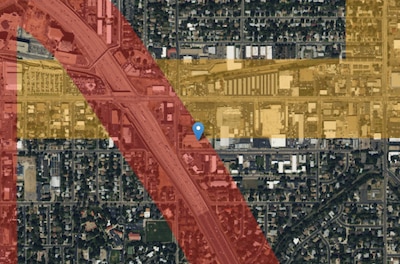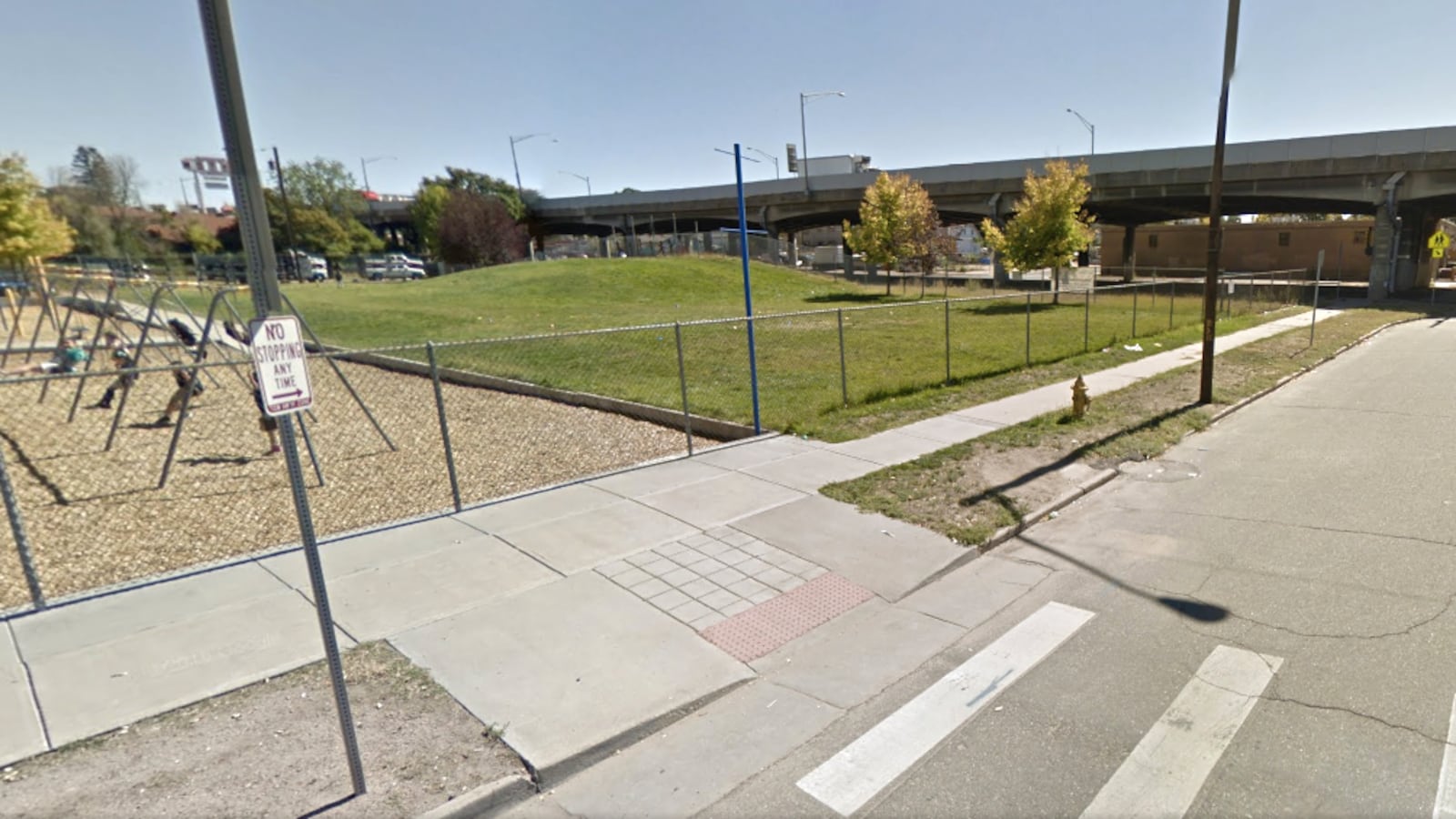Just a few hundred feet from the front doors of Highline Academy Charter School’s southeast Denver campus is Interstate 25, where more than 200,000 vehicles rush by each day.
At Swansea Elementary School in north Denver, kids frolic near the busy Interstate 70 overpass that abuts the playground. Three miles west, at a charter school called STRIVE Prep – Sunnyside, the same highway looms just past a chain link fence next to the school.
The three schools are among 29 in Denver Public Schools — 10 of them charters — that sit near high-traffic roads and the invisible air pollution those routes generate daily. Experts say such pollution can stunt lung development, aggravate asthma and contribute to heart disease, but there’s little public awareness about the problem and mitigation efforts are sparse.
A new online mapping tool, part of a joint investigative project by two nonprofit news organizations, the Center for Public Integrity and Reveal, puts the issue in stark relief. Residents across Colorado and the nation can easily check which schools fall into red zones where traffic volume, and the accompanying air pollution, is worst, and orange zones where traffic volume is lower, but still potentially problematic for kids and staff who may spend long hours at their schools.

The Center for Public Integrity provided Chalkbeat with raw data for schools with Denver addresses. While most were DPS schools, a couple dozen were schools in neighboring districts, including Cherry Creek, Aurora, Westminster, Mapleton, Sheridan and Jefferson County.
Eleven DPS schools — educating more than 8,000 students — fell into the red zone, which means they sit within 500 feet of roads carrying more than 30,000 vehicles a day on average. Those include charters such as Highline and Strive Prep – Sunnyside, and traditional public schools such as Swansea and Steele elementaries and George Washington, Lincoln and East high schools.
Another 18 district schools, plus one in the Cherry Creek district and one in the Adams 12 district, fall into the orange zone, which includes schools that are within 500 feet of roads carrying more than 10,000 vehicles and more than 500 trucks daily. The 18 DPS schools include two additional STRIVE – Prep locations, two schools inside the downtown administration building and the district’s magnet school for students designated as highly gifted: Polaris at Ebert Elementary.
DPS officials say air pollution resulting from schools’ proximity to busy roadways hasn’t been discussed previously and that mitigation measures — such as high-grade air filters — aren’t in place at most affected schools.
“We haven’t had this conversation before,” said district spokeswoman Alex Renteria.
Sometimes schools end up near busy roadways because that’s where districts can buy cheap land. But population growth, development trends and major transportation projects can also dramatically change the fabric of a school neighborhood. Swansea Elementary, for example, was built in 1957, before I-70 sliced through north Denver in the 1960s.
The problem of traffic-related air pollution near schools is not exclusive to big cities like Denver. It can be found in suburban and rural areas around the state and the rest of the country. Many school districts across Colorado — from Montrose to Steamboat Springs to Greeley — have at least one school within 500 feet of high-traffic routes.
Charters harder hit
The investigation by the Center for Public Integrity and Reveal, which looked at trends nationwide, found that charter schools are more likely than traditional public schools to be located close to busy roads.
That’s true in Denver, where 22 percent of the district’s charter schools were located near a busy road during the 2014-15 school year, compared to 13 percent of other district schools. Nationwide, about 9 percent of schools are near busy roads, according to the analysis.
Officials at the most impacted Denver charter schools had little to say about the issue of traffic pollution.
Christine Ferris, executive director of Highline Academy, wrote in an email: “We can’t really do much about our location and although it would be obvious to anyone who visits us, having the information highlighted on Chalkbeat isn’t my favorite idea.”
She canceled a subsequent interview with Chalkbeat.
Chyrise Harris, senior director of communications and marketing for the STRIVE Prep charter group, said via email, “STRIVE Prep operates all of its schools in district facilities and works collaboratively with the district to ensure that all students, regardless of where they live, have access to a safe, high quality school near them.”
Jessica Johnson, general counsel and director of policy for the Colorado League of Charter Schools, said in growing cities like Denver there’s limited inventory when it comes to school sites. Charter schools may end up along high-traffic routes because that’s where the chartering district has vacant space and also because such roads provide needed proximity to bus or train stops.
Of the 10 Denver charter schools near busy roads, seven are in district-owned buildings. The three that aren’t are Highline, Cesar Chavez Academy and Justice High School.
While Johnson said being close to busy roads is a fact of life for urban charter schools, she noted the impact of traffic-related air pollution is an important health and wellness issue — one that hasn’t been on the charter community’s radar.
“This isn’t an issue that we’ve seen a lot of research into locally or a lot of conversation on,” she said.
Mitigation measures
Vehicle exhaust contains a variety of harmful components, including small particles, carbon monoxide and carcinogenic compounds. While outdoor areas like school playgrounds and sports fields pose an obvious risk, the air inside buildings can suffer, too, because particles, vapors and gases often seep inside.
High-grade air filters — those rated MERV 16 — can make a big difference. According to the Center for Public Integrity and Reveal investigation, MERV 16 filters installed in California schools caught about 90 percent of fine and ultrafine particles, which are key contributors to traffic-related health problems.
Denver schools use lower-grade filters, those rated either MERV 8 or MERV 10, according to district officials.
Air-conditioning can also help somewhat, allowing schools to keep some pollution at bay by shutting doors and windows in hot weather. Of the 29 DPS schools most impacted by roadway pollution, only four don’t have at least partial air-conditioning. Those are Valverde and Steele elementaries, Polaris at Ebert Elementary and STRIVE Prep – Sunnyside. While a handful of the 29 schools will get additional air-conditioning with funds from Denver’s recent voter-approved bond, those four are not on the list.
Swansea Elementary, the second most impacted Denver school after the southeast Highline Academy location, will be getting short-term and likely longer-term relief from traffic pollution.
Renteria said as part of a project underway now, the school is getting a new heating, ventilation and air-conditioning system that will include MERV 16 filters. It will also get new doors and windows.
Additionally, a planned highway widening project will convert the current overpass next to Swansea to a covered below-grade route. Research from the Environmental Protection Agency suggests vehicle emissions are lower near below-grade roads with steep walls. The same is true for routes with certain kinds of sound barriers or roadside vegetation.
The city will monitor air quality on Swansea’s grounds during and after construction.
Here is the list of schools classified as “red” or “orange:”
Red Zone Schools
These “red zone” schools are within 500 feet of roads carrying more than 30,000 vehicles a day on average.
Orange Zone Schools
These “orange zone” schools are within 500 feet of roads carrying more than 10,000 vehicles a day and more than 500 trucks on average.

